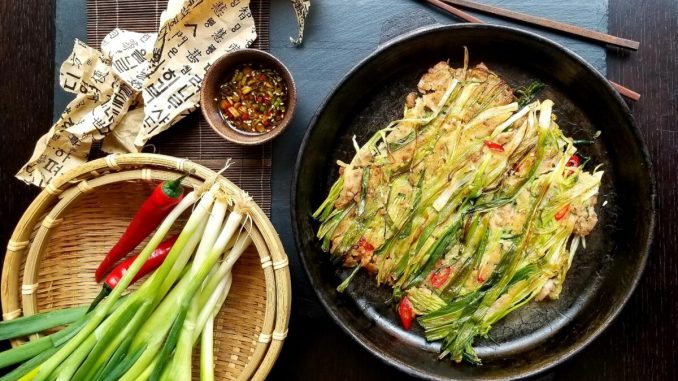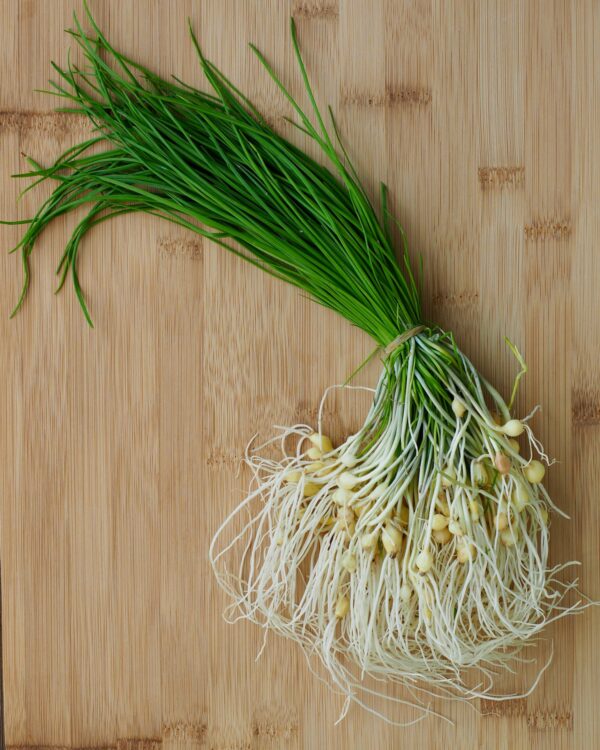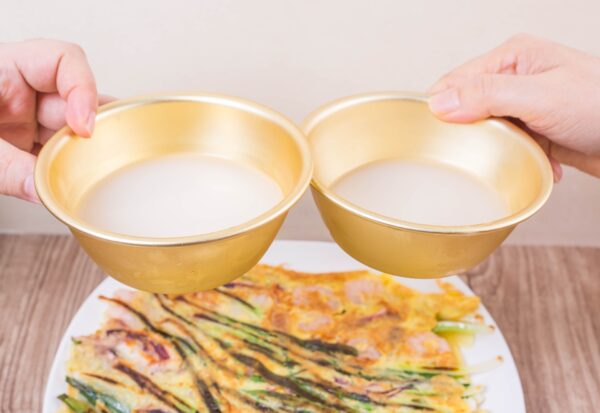
Pajeon are savory, chewy-crisp, and packed with bright green scallions—and whatever else you like
When I was little, I always looked forward to the rain. Rainy days meant one thing to me: pajeon, a crispy Korean scallion pancake, often loaded with meat or seafood.
My mom would get out her old, dented, red electric griddle pan, plug it in, and drizzle it generously with oil. She would crank up the plastic black dial, and once the pan was hot, she’d carefully lay out an array of scallions, mixed with some wild garlic and even onion grass that she had foraged from our backyard. Then, came a scattering of ground pork—and sometimes other leftovers from the fridge, too—followed by a sprinkle of sliced red chiles. To bind it all together, she’d drizzle a few ladles of a simple, seasoned flour-and-water batter right over the top.
I distinctly remember the mouthwatering sizzling sound the pancakes made as they cooked—much like the sound of rain, which is how it’s thought that the Korean tradition of eating pajeon on rainy days came about. The savory aromas of caramelizing onions and pork would always make my stomach rumble, and I would wait anxiously as my mom flipped the pancakes, using chopsticks and a large spatula.
Sometimes, she would cut the scallions into small pieces and make little bite-sized pancakes that I’d find in my lunchbox. Other times, large ones the size of pizzas would come to the table, to be ripped apart with scissors and chopsticks.
Scallions are always a staple in pajeon—pa means scallion, and jeon refers to anything flat, coated in some kind of batter, and pan-fried—but the other fillings depended on the occasion. Usually, we ate homey, practical versions stuffed with leftovers—bits of spam, beef, corn, and cold cuts revived by a chewy-crisp batter. But when guests came over, or for special occasions, my mom would bring forth elaborate haemul, or seafood, pajeon, studded with briny morsels of shrimp, squid, oysters, mussels, and even scallops.
It’s thought that this much-loved pancake dates back to Korea’s Joseon Dynasty (1392–1897), to Dongnae city of Gyeongsang province. This region is famous for its sweet and plentiful green onions. The Dongnaesung fortress, which lies in modern-day Busan, was the center of many battles during the Imjin War, and legend says that after Japanese invaders were defeated, green onions were pulled from the ground and tossed into the air in celebration. Dongnae pajeon was created to honor the victory, and the king was promptly presented with this commemorative dish. Nowadays, you will find some form of pajeon in most Korean restaurants, with some specializing in specific styles.
Making Pajeon at Home
In Korea, pajeon is commonly made with wild green onions or tree onions (jjokpa), which grow as abundantly as weeds in the springtime, but any green onions work just fine. Traditional pajeon has just enough batter in it to hold the ingredients together, so that the bright green stalks can shine through.

The batter is the key—a mixture of rice flour and wheat flour to achieve the right balance of crispiness and chew, while still being able to bind it all together. An egg is sometimes thrown into the batter as well, or cracked on top as the pajeon cooks, with the yolk promptly broken to create a visually appetizing result.
Pajeon can be simple or elaborate, an appetizer or a main course. But however you eat it, don’t forget the makgeolli, Korea’s cloudy rice wine, on the side. Much like fried chicken and beer, pajeon and makgeolli is one of Korea’s great pairings—one best enjoyed on a rainy day.

Pajeon (Korean Scallion Pancakes With Pork)
For the batter, I like to use a combination of all-purpose flour, cornstarch, and rice flour to get the right balance of crispiness and chewiness. The pork complements the scallions perfectly, but feel free to use any other protein of your choice, or none to make it vegetarian. Serve as an appetizer or lunchtime meal.
Makes 2 large pancakes
For the Dipping Sauce
- 6 tablespoons soy sauce
- 2 1/2 tablespoons rice vinegar
- 1 tablespoon thinly sliced red chiles
- 4 1/2 tablespoons toasted sesame oil
- 2 teaspoons sesame seeds
- 2 scallions, very thinly sliced on a bias
For the Pajeon
- 1/3 cup all-purpose flour
- 1/3 cup cornstarch
- 1/3 cup white rice flour (not sweet or glutinous rice flour)
- 1/2 teaspoon kosher salt
- 1/4 teaspoon baking powder
- 1/4 teaspoon white sugar
- 1/4 teaspoon onion powder
- 1/8 teaspoon garlic powder
- 1 teaspoon doenjang
- 2/3 cup water
- 12 scallions, roots only trimmed and sliced lengthwise, divided into two portions
- 1 cup zucchini, julienned, divided into two portions
- 7 ounces ground pork
- 1 fresh red chile, thinly sliced on a bias, seeds removed, if you like, and divided into two portions
- 2 large eggs
- Vegetable oil for cooking
In a small bowl, stir together all of the ingredients for the dipping sauce and set aside.
In a large bowl, mix together the all-purpose flour, cornstarch, rice flour, salt, baking powder, sugar, onion powder, and garlic powder. Whisk until well incorporated.
In a small bowl, using a fork, mix together the doenjang and the water until dissolved. Pour into the flour mixture, and mix together until a smooth batter forms. The batter should have the same consistency as a typical Western breakfast pancake batter; if it’s too thick, add a little more water.
Drizzle a little oil into a large nonstick skillet and place over medium-high heat. Tip in the ground pork and sauté until cooked through. Remove the pork from the pan, leaving behind the drippings, and place into a bowl.
Drizzle more oil into the same pan, then arrange half of the scallions on the pan in a row. Top with half of the zucchini, and then scatter on about half of the cooked pork. Finish by sprinkling on half of the sliced red chile.
Using a large spoon, ladle half of the batter onto the pan, over the vegetables and pork, taking care to include the edges. Crack 1 egg on top of the batter and break the yolk, using a spoon spread the egg out over the vegetables. Drizzle in more oil if necessary. Flatten with a large spatula and fry until dark golden brown on the bottom, about 2 to 3 minutes. Flip carefully and cook for another 2 to 3 minutes. Remove and place on a rack or paper towel-lined plate to drain. Repeat for a second pancake.
Serve immediately with dipping sauce on the side.
Judy Joo is a chef, restaurateur, author, and TV personality. Her newest book is “Judy Joo’s Korean Soul Food.”






Be the first to comment